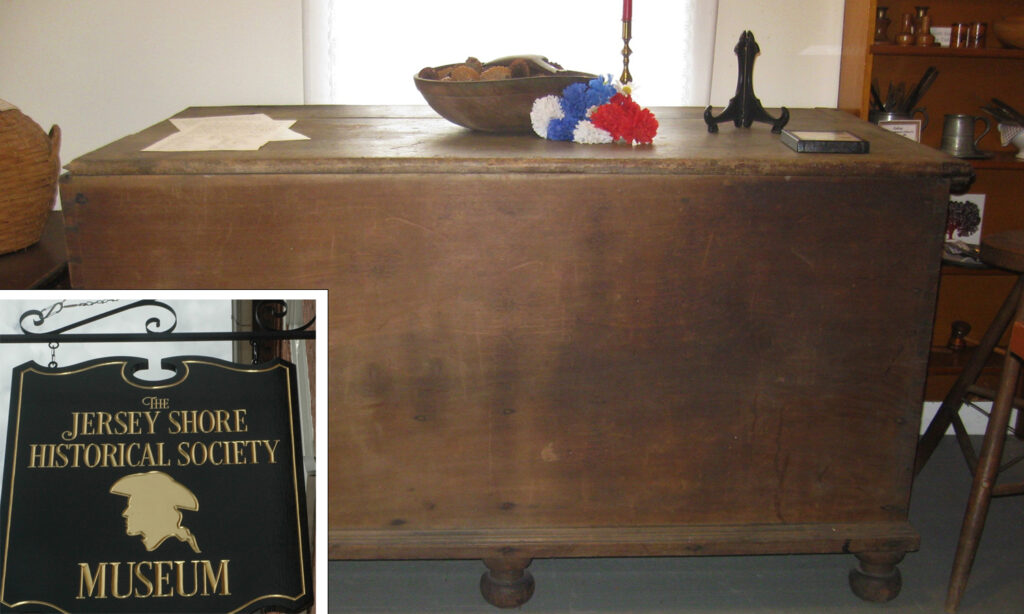
JERSEY SHORE – Resting in the back of the Jersey Shore Historical Society is a large wooden box that looks like it could fit a human body.
“We get kids asking us if there is a body in there,” Tina Cooney, president of the Jersey Shore Historical Society, said with a laugh. “Men will look at it and say, ‘Look at the craftsmanship of it’ while women will ask us, ‘Is it okay if I touch it?'”
It is very common for visitors to want to touch a piece of history and the grain box, as it is called, has a unique history, Cooney said.
It’s creator
“This box was used in the Great Runaway of 1778,” Cooney said. It carried grain and other supplies when settlers were forced to flee from marauding Indians. Its creator, a man named Alexander Hamilton, did not fare as well. This Hamilton, not to be confused with the same-named statesmen and George Washington confidant, was born in Scotland in 1725 and settled in Pine Creek.
“Hamilton was the genius of the neighborhood, and was equally familiar with all the tools required for the work of putting up a house, a piece of furniture or an implement to cultivate soil,” author Edwin MacMinn said in his book “On the Frontier with Colonel Antes.” MacMinn called him a “genius” and said that women in his area “knew that the household requirements would be started right” when he was at work.
It was in 1774, that Hamilton built the grain box. Mary Hamilton Washburn, a descendant of Hamilton’s, wrote about the box in an article available at the Jersey Shore Historical Society. “It is of solid black walnut boards, 30 inches wide and unspliced, from the virgin walnut trees that grew in the land that he purchased from the Indians in 1772.” Cooney added that the box has two iron hinges and two compartments inside. She described it as incredibly heavy.
Hamilton would go on to serve in other leadership roles in the Pine Creek community. According to his entry in Geni.com, he was a “member of the Committee of Safety for Northumberland County.”
In 1776, Hamilton was part of the Pine Creek Declaration of Independence that involved the Fair Play Men society. Cooney said that this area of Pennsylvania was not part of the original Thirteen Colonies thanks to the first Treaty of Stanwix in 1768 between the British and the Iroquois nation.
The Great Runaway
In 1778, with the rest of Pennsylvania caught up with the American Revolution, the Native Americans decided to purge the area of the Western Branch of the Susquehanna River of the settlers. Cooney said from the Indians’ point of view, the settlers were “squatters.” In June 1778, the Indians massacred whites in the Williamsport area, and from July 1st to July 8th, the settlers fled Fort Augusta in Sunbury, which is why it is remembered as the Great Runaway.
According to Washburn’s article, “The (grain) chest was carried down the river bank, lashed to two canoes and, filled with the finished product of forty bushels of wheat, towed down to Fort Augusta … It remained there until 1784.”
Hamilton was soon “appointed Captain of all the people of the West Branch Valley.” Washburn said. Cooney said that while on patrol near Linden, he was scalped.
By 1784, a second treaty of Stanwix was written and it allowed the settlers to return to the Pine Creek/Jersey Shore area. Cooney said that Alexander’s son, Robert Hamilton returned with the grain box.
As Robert Hamilton built a new home to raise a family, he lowered the grain bin into the second floor through the roof. “It stood there and was used as a meal chest for one hundred years,” Washburn said.
Passed through the years
Washburn said that when Robert Hamilton died, his son John Hamilton, took the grain bin to his home where it remained in the Hamilton family until the 1930s. The bin eventually ended up in the possession of the Blair County Historical Society. In 2005, Blair County donated it to the Jersey Shore Historical Society.
James W. Allen, then treasurer of the Jersey Shore Historical, thanked Blair County and called the box “impressive.”
“On behalf of our members, I thank the Blair County Historical Society for donating the Hamilton storage chest to the Jersey Shore Historical Society,” Allen said in a letter, available on display. “Special thanks to you for arranging for the transfer of the chest from Altoona to Jersey Shore.”
Allen said members of Jersey Shore “were able to get the chest through one of the exterior doors without altering the chest in any way.” For the better part of two decades, the chest has remained at the Jersey Shore Historical Society for any visitors to see and touch.
She calls it one of the “crown jewels” of the historic society.
“It’s one thing to explain history, but it is another thing to let people see and touch it. Let them consider where it came from and its history. I mean this is an artifact from the days of the American Revolution,” Cooney said. “I am excited we can share it and help people learn more about our past.”



